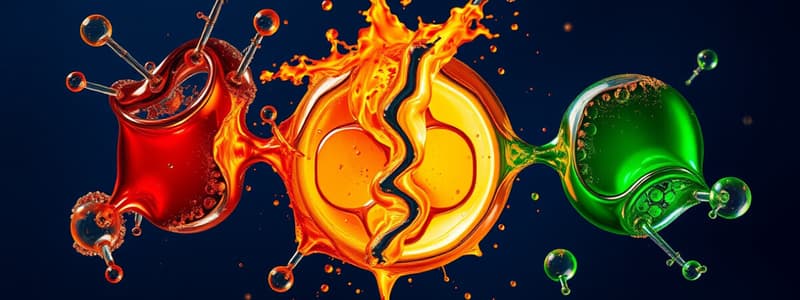Podcast
Questions and Answers
The conversion of pentanal into pentanoic acid is an example of:
The conversion of pentanal into pentanoic acid is an example of:
- Elimination
- Substitution
- Reduction
- Oxidation (correct)
What type of bond breaking occurs in this process? CH3COOH → H+ + CH3COO−
What type of bond breaking occurs in this process? CH3COOH → H+ + CH3COO−
- Homolytic
- Ionic
- Electrophilic
- Heterolytic (correct)
A nucleophile:
A nucleophile:
- Always has a positive charge
- Donates a pair of electrons (correct)
- Accepts a pair of electrons
- Always has a negative charge
Complete the equation for the reaction of 2-chloro-2-methylpentane with aqueous sodium hydroxide: CH3-C2H3Cl-CH2-CH2-CH3 + ______ → ______ + ______
Complete the equation for the reaction of 2-chloro-2-methylpentane with aqueous sodium hydroxide: CH3-C2H3Cl-CH2-CH2-CH3 + ______ → ______ + ______
In the reaction of methane with chlorine, ultraviolet light causes:
In the reaction of methane with chlorine, ultraviolet light causes:
When propane reacts with chlorine, a mixture of products forms. Which product is the best evidence for a free radical mechanism?
When propane reacts with chlorine, a mixture of products forms. Which product is the best evidence for a free radical mechanism?
The conversion of butanoic acid into butan-1-ol is an example of:
The conversion of butanoic acid into butan-1-ol is an example of:
An electrophile:
An electrophile:
Which equation represents a substitution reaction?
Which equation represents a substitution reaction?
Which of these species is not a nucleophile?
Which of these species is not a nucleophile?
An electrophile is a species that:
An electrophile is a species that:
Which equation represents a termination step in the reaction between chlorine and chloromethane?
Which equation represents a termination step in the reaction between chlorine and chloromethane?
Name the types of reactions that occur when alkenes react with halogens.
Name the types of reactions that occur when alkenes react with halogens.
Classify each of the following reactions as initiation, propagation, or termination: i) C3H7 + CH3 → C4H10 ii) 2O → O2 iii) F + C2H6 → HF + C2H5.
Classify each of the following reactions as initiation, propagation, or termination: i) C3H7 + CH3 → C4H10 ii) 2O → O2 iii) F + C2H6 → HF + C2H5.
Methane reacts with chlorine in the presence of UV radiation to produce chloromethane: CH4 + Cl2 → CH3Cl + HCl. A methyl free radical forms in this reaction. Draw the dot-and-cross diagram for the methyl free radical.
Methane reacts with chlorine in the presence of UV radiation to produce chloromethane: CH4 + Cl2 → CH3Cl + HCl. A methyl free radical forms in this reaction. Draw the dot-and-cross diagram for the methyl free radical.
Write an equation to represent the following: Homolytic fission of the carbon-to-carbon bond in C3H8.
Write an equation to represent the following: Homolytic fission of the carbon-to-carbon bond in C3H8.
Flashcards are hidden until you start studying
Study Notes
Types of Reactions and Mechanisms
- Pentanal conversion to pentanoic acid is an oxidation reaction due to the addition of oxygen.
- Butanoic acid to butan-1-ol involves reduction through the addition of hydrogen.
- Nucleophiles donate a pair of electrons, characterized by having a lone pair, while electrophiles accept electrons.
Bond Breaking
- Reaction of acetic acid dissociating into H+ and CH3COO− illustrates heterolytic bond breaking, producing ions.
- Ultraviolet light induces homolytic fission of Cl-Cl bonds during methane and chlorine reactions, resulting in free radicals.
Reaction Classifications
- Alkene reactions with halogens are addition reactions, converting double bonds to single bonds by attaching halogens.
- Substitution reactions replace one atom or group with another, as demonstrated in ethane reacting with fluorine to form chloroethane and HF.
Free Radical Mechanism
- A mixture of products from propane's reaction with chlorine produces evidence of free radical mechanisms, indicated by the formation of C3H7Cl.
- Termination in free radical reactions, such as CH2Cl + Cl → Cl2, consumes free radicals to form stable products.
Propagation and Termination
- Propagation involves free radicals reacting with molecules, while termination occurs when two radicals combine to form a stable product.
- Two steps in the propagation of chloroheptane are the reaction of chlorine radicals with heptane to form hydrocarbon products and subsequent chlorine addition.
Formation of Dichloroheptane
- Excess chlorine in reactions can lead to further substitutions, resulting in dichloroheptane from previously formed products.
Polymerization
- Ethene and but-1-ene can form a polymer through their repeat units, represented as [-C-C-]n, resulting from the saturation of double bonds in the monomers.
Additional Notes
- The methyl free radical formed from methane and chlorine can be represented using a dot-and-cross diagram, illustrating the bonding and electronic structure.
- Homolytic fission of carbon-to-carbon bonds shows equal splitting, producing separate radicals.
Studying That Suits You
Use AI to generate personalized quizzes and flashcards to suit your learning preferences.




